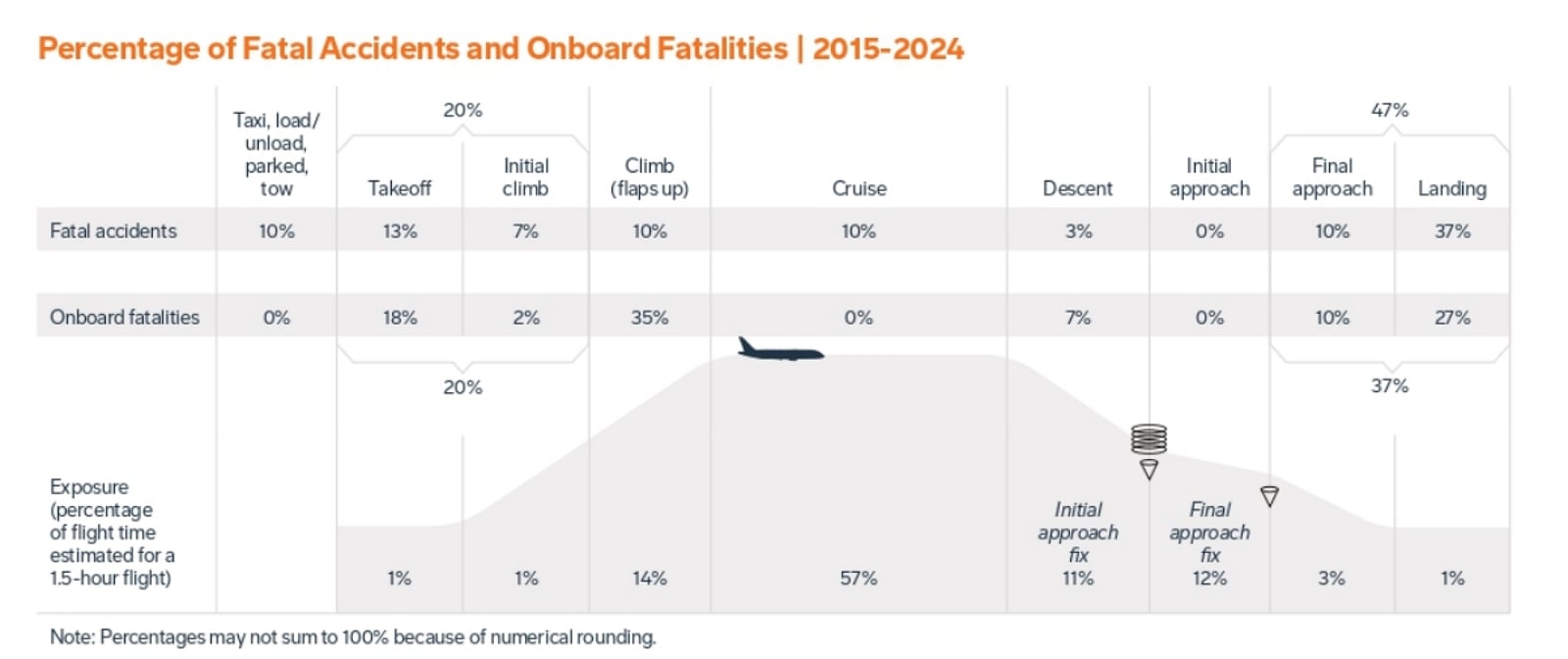Ahmedabad plane crash news: Data show that the majority of all aviation accidents occur during the short window of time when the aircraft is taking off or landing. Here’s why
An Air India Boeing 787 Dreamliner flying from Ahmedabad to London Gatwick with 242 people on board crashed shortly after takeoff on Thursday afternoon. The aircraft went down in the densely populated Meghani Nagar, right outside the perimeter of Ahmedabad’s Sardar Vallabhbhai Patel International Airport. Thick plumes of black smoke were visible for miles. Click here for latest updates.
Details of what caused the crash are still not available, and it may be months before there is any official confirmation on the matter. That said, data has shown that most crashes take place during landing, takeoff, or the phases immediately before/after these two events. Here’s why.
What the data say
According to data from the trade group International Air Transport Association (IATA), the landing phase accounted for more than half (53%) of all aviation accidents from 2005 to 2023. The takeoff phase was the next most deadly, accounting for 8.5% of all accidents (see Chart 1).

The phases immediately before/after these two events — the approach phase before landing and the initial climb phase after takeoff — contributed to another 8.5% and 6.1% of accidents, respectively. Rejected takeoffs accounted for 1.8% of accidents.
Boeing’s own data, which looked at fatal commercial jet accidents from 2015 to 2024, also paints a similar picture (see Chart 2).

The takeoff and the initial climb phases accounted for 20% of all such accidents as well as 20% of all fatalities despite accounting for only 2% of exposure. The subsequent climb phase accounted for another 10% of fatal accidents and, notably, 35% of fatalities, despite accounting for only 14% of exposure.
On the other hand, the final approach and landing phases accounted for 47% of all accidents and 37% of fatalities, despite making up 4% of exposure. The descent phase accounted for another 3% of accidents and 7% of fatalities.
But despite making up 57% of exposure, the cruise phase, that is, when the aircraft is flying at a stable altitude and steady speed, accounts for only 10% of fatal accidents and less than half a percent of fatalities.
(Boeing has defined “exposure” as the percentage of flight time estimated for a 1.5-hour flight. For longer flights, the cruise phase has even more exposure, while takeoff and landing has less exposure. Also note that IATA and Boeing define these phases slightly differently, and as such, the two sets of data are not perfectly comparable).
Why takeoffs and landing are deadliest
Both datasets mentioned above make one thing clear: an aircraft is at the highest risk of meeting an accident at the beginning and end of the flight. But why?
The most basic explanation for this is that during these phases, aircraft are what in aviation lingo is called “low and slow”, leaving pilots very little time to react if something goes wrong.
“When cruising at 36,000 feet, a pilot has the luxury of time and space to course correct. Even if both engines go out, the plane won’t just fall out of the sky. It becomes a glider. In this state, a typical airliner loses about a mile in altitude for every 10 it moves forward, giving the pilot a little over eight minutes to find a place to land. But if something goes wrong on the ground, that window shrinks considerably,” according to an article by Business Insider.
A multitude of environmental and situational factors put stresses on the aircraft during the takeoff and landing phases, meaning that the probability of something going wrong is also higher at this time.
For instance, it is more likely that the wings of an aircraft will stall during takeoff than while in stable flight. A stall is essentially a condition where the wings of an aircraft lose lift due to the critical angle of attack being exceeded. In simpler words, if during takeoff, the pilot takes an excessive nose up attitude, the aircraft can simply fall out of the air.
While in the rare occasion, stalls can occur mid-flight, at higher altitudes, pilots have a lot more time to take corrective action, which in the case of stalls is to, somewhat counterintuitively, reduce the angle of attack or point the nose down.
Aircraft engines are also under the maximum stress during takeoff, especially the moment when the hundreds of tonnes heavy vehicle has to fight the forces of gravity to lift off from the ground. This too increases the possibility of failures.
On the other hand, the pilot herself is most stressed during landings. This is because this is the most technically challenging aspect of flying, requiring the pilot to consider a host of variables, from wind speed and direction to how heavy the aircraft is, while making constant decisions regarding attitude and speed. Most aviation accidents, more so during the landing phase, occur due to pilot error.
Lastly, aircraft are also more likely to encounter bird strikes, turbulence, and unavoidable inclement weather at low altitudes, increasing the likelihood of accidents
Still safest mode of travel
Nonetheless, it is much safer to travel by airplane than by any other mode of transport. And data show that aviation has become progressively safer over the years.
According to data from the UN body International Civil Aviation Organisation (ICAO), accidents per million departures in commercial flights went down from 4.9 in 2005 to 1.9 in 2023. Notably, the ICAO’s definition of an aircraft accident is fairly broad, including even minor events where the aircraft is damaged and needs repairs, or temporarily goes missing.
Similarly, air crash fatalities have shown a general downward trend, although this statistic is more prone to year-on-year fluctuation. For instance, in 2014, two major accidents contributed to almost 60% of the 911 total fatalities.

